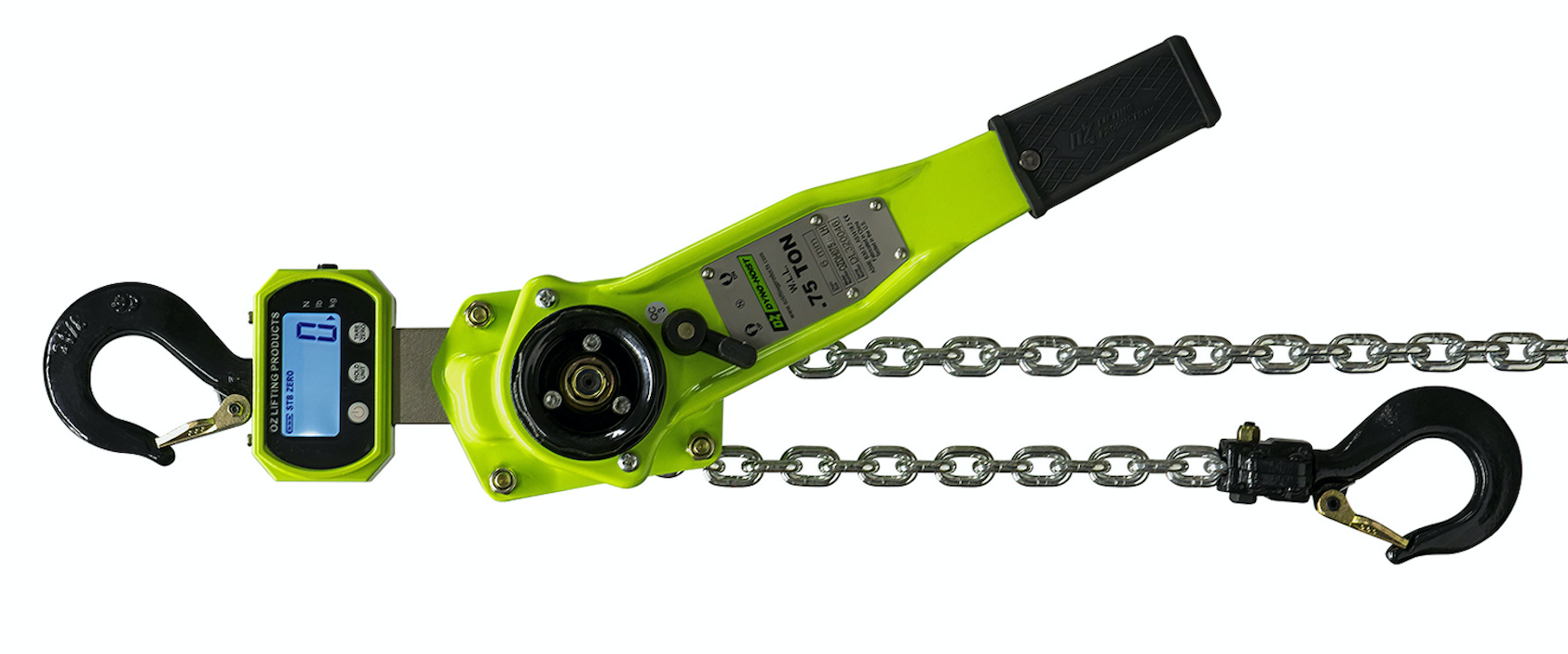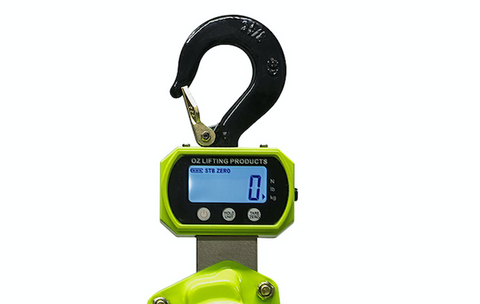
A Dynamometer in a Lever Hoist
Meet our newest product—OZ Lifting’s Dyno-Hoist—a dynamometer-equipped lever hoist from 0.75 to 9 tons capacity (up to 3 tons in stock). And who better to walk us through it than the guy who named it? Rich Miller, sales manager, remembers when he first saw the concept that will forever change the way lever hoists are used.
We all know what lever hoists do. We’ve also heard them called "come-a-longs” or even “pullers”. They are diverse tools, in that they can be used for lifting and puling, or in some applications tightening and stretching. It means you can find them used in the horizontal or vertical position, where they might be employed instead of a hoist.

A dynamometer in a lever hoist—that's what Dyno-Hoist brings to industry.
I recently saw one of our premium lever hoists (sold on this store) in a typical application. The unit requires minimal load lifting effort and is ideal for frequent lifting and pulling applications. It offers fully enclosed gearing, forged alloy steel hooks, and safety chain stop. The powder-coated, steel construction, ensures durability and corrosion preservation for demanding jobs. In this case, the user was utilizing an eyebolt for one connection to the load, a roundsling in choke sling for another; an adjustable chain sling hooked into one and, for adjustment, our lever hoist hooked into the other. You’ve probably seen a similar scenario.
Lever hoist capacity
Our capacity range—0.75, 1.5, 3, 6, and 9 tons—covers most applications, and we have an industrial lever hoist range should that better fit the requirements of the job. So why then did we invest the research and development (R&D) time / money into a third lever hoist range—Dyno-Hoist—a dynamometer-equipped product in the same capacities?
Why was there a gap in the market to give users a real-time reading of the load (in kilograms or pounds) they are applying to the hoist, whether it be a lifting or pulling application?
They’re good questions. And we have the answers:
Where you would have previously needed to use a shackle, dynamometer, and hoist, with Dyno-Hoist, you gain a significant amount of headroom because the load cell is an integral part of the unit.
Our industrial line of lever hoists already offers a good choice if users know the weight of the load. And the premium line is based on the same hoist but has overload protection. But Dyno-Hoist emerges as the first choice in any application where you need to know the weight of the load being applied to the hoist. As Steve Napieralski, president here at OZ Lifting, told trade media recently, there is nothing out there in the marketplace like this hoist.
Also, while the premium hoist has proved useful if the load weight is unknown because the overload protection will activate at approximately 50% above the load rating, with Dyno-Hoist, an overload alert is triggered at 126%.

The product gives users a real-time reading of the load (in kilograms or pounds) they are applying to the hoist.
Remember, the American Society of Mechanical Engineers (ASME) requires that when a hoist is repaired or recertified, it gets tested at 125% of the rated capacity. We wanted to be sure that the hoist could be tested to that capacity without timing out.
Against best practice advice, users could operate it beyond that point, but they would have no knowledge of the load being applied.
It’s worth adding that the dynamometer fitting itself can retrofit to either of the industrial or premium lever hoists—so if a user has one of those models, they can purchase the load cell and complete installation.
It’s probably true to say that when you are pulling or tensioning you likely don’t know how much force it's going to take to accomplish your task. The load cell will tell you how much load is being applied to the product being pulled or tensioned.
- This article isn’t about the product’s finer details, but users point out that features include all-steel construction; steel handle with rubber grip; zinc-plated load chain; forged alloy steel hooks; and fully-enclosed gearing.
- Standard AA batteries offer a run time of 150 hours, but the product can be plugged into a 115/1/60 outlet.

The product boasts a steel handle with rubber grip—and a zinc-plated load chain.
Where might Dyno-Hoist be used?
We’re still finding out about the myriad of applications where it might be useful. We recently displayed it at several industrial trade shows and there was specific interest from the aviation industry, as they must tension parts for testing and need to know the exact weight.
MODEX attendees were very impressed with it; they represented companies involved in manufacturing, warehousing, logistics, and distribution, with most of the Fortune 500 represented. Associated Wire Rope Fabricators (AWRF) Product Information Exhibition (PIE) attendees, meanwhile, were equally amazed that there wasn’t already something else like this on the market.

OZ Lifting showed Dyno-Hoist to MODEX attendees.
In October, we’re excited about taking Dyno-Hoist to Water Environment Federation’s WETFEC event where we’ll share it with people who will transform the future of water. There is no better place than WEFTEC to meet water professionals from around the world and experience first-hand the best in water quality education, leading experts, the latest technology and trends, and proven solutions. Dyno-Hoist will be a perfect fit for this end-user sector as well.

Attendees at the latest AWRF event were equally impressed with the product.
You’re probably imagining applications where you could utilize it right now to get a real-time reading of the load (in kilograms or pounds) you are applying to the hoist.
Why is it called Dyno-Hoist?
People are crediting me, sales manager here at OZ Lifting, for giving Dyno-Hoist its name, but really it wasn’t a complicated process. I just connected the words ‘dynamometer’ and ‘hoist’… Dyno-Hoist. I also named our Tele-Pro davit crane, which allows users to leverage the benefits of other lifting technologies in its range, while telescoping the boom in and out under load; and the CompOZite and CompOZite Elite carbon fiber models. We were probably in the boardroom, writing on the whiteboard, for longer in each of those occasions. All of these products are available at this store.
Other Dyno-Hoist facts
The net weight of the units (head only), is 16.5, 27.94, 45.1, 66, and 96.80 lbs. in order of capacity, while the effort to lift the safe working load (SWL) in each instance is 31.4, 49.5, 72, 76.5, and 81 lbs. The first three models in the range have one fall of chain and the 6 and 9 tons versions, two and three falls respectively. Dyno-Hoist meets or exceeds CE, ASME B30.21, and AS 1418.2 standards. Each hoist is load tested and arrives with a test certificate, one-year warranty, and a free set of latches.

What will you use your Dyno-Hoist for?
Rich Miller, sales manager, OZ Lifting

Leave a comment